|
||||||||||
|
Vera’s Last Act As Chesapeake Bay’s most glamorous restaurateur exits the stage, a new dream takes shapeby Sandra Olivetti MartinIf Vera Freeman had been in the movies, she couldn’t have acted her way to a better-scripted ending. But that was the dream the aspiring girl from Montana deferred when Dr. Freeman, optometrist to the stars, proposed to her. “It can be like this every day,” he said. “We’ll have a wonderful time.” I really didn’t do any modeling or dancing. I got a job at the telephone company. ‘I can’t leave my job,’ I told Dr. Freeman. ‘All right,’ he said. ‘I’ll take you to work every day.’ The first day he said, ‘I feel like I’m going on a fishing trip, getting up so early.’ I went into the office and looked around and asked myself, what am I doing here? —Bay Weekly interview: July, 1996 “And we did have a wonderful time,” she says six or seven decades down the road. Time’s Winged ChariotOn this June afternoon in 2006, as the sun gilds Leonard’s Creek with a glory that pinches your heart, Vera is watching the end of the dream she lived instead of the one she left in Hollywood those many years ago.
What was once so utterly familiar has changed, as former homes do, becoming places you no longer belong. On the White Sands Road exit from Route 2-4, the sign is down, and Vera’s ageless, exotic effigy no longer beckons. Vera’s White Sands, the advertised destination, has been gutted and her signature pink painted over. This weekend, Vera’s White Sands Beach Club reopens, recast by neighbors Steve Stanley and Lisa Del Rico. Pale — sunlight seems never to have touched her skin — and bemused, Vera comes as guest to her former domain, the Calvert County promontory she colonized as a bit of Polynesia on the Patuxent. She is here to be honored. Her gnarled hands, soft from a lifetime of luxury, will be imprinted in wet concrete. Then it will be over, and she will go home. Instead of Hollywood, Vera made her home in Calvert County, where she arrived early in the 1950s as the accidental but willing hostage of two avid and successful real estate speculators, her husband, Dr. Freeman, and Louis Goldstein. Dr. Freeman was also into real estate and he always wanted to come to the East. I didn’t know why at first. Then I read in the Washington Star that he was the pioneer developer of the club aspect of Virginia and Maryland. This was all trees around here. Louis Goldstein, who owned the property, brought us out on a terrible winter day. ‘Why do you want to go on a day like this?’ I asked Dr. Freeman. ‘Because I want to see it at its worst,’ he said. He bought 800 acres and built White Sands. I brought the white sand and the palm trees. On this promontory over two creeks, she built the castle of her dreams. Ever since I was a little girl, I wanted a castle. I’d walk to school through the snow — in Montana it snows every day — and I’d see these tumbleweeds, these 10-feet tumbleweeds with snow and ice shining like glitter. They looked like castles. I thought, someday I’ll have a castle. Then she and Dr. Freeman built the stage on which she would act an exotic, one-woman show for the next half century. Vera’s Long Day
“I didn’t find it like this 41 years ago. I made it this way,” Vera has said of her Calvert County Shangri-la, eponymously named Vera’s White Sands Restaurant and Marina. She cultivated banana palms among the dogwood on her promontory that overlooks St. Leonard’s and Johns creeks. She decorated it with exotica imported from the Orient, especially the Pacific Islands she loves. On my first trip to the Orient in 1973, we bought all of these things. Always after that we went, Dr. Freeman and I together, traveling and buying and collecting the things that fill this place. After he died, in 1980, I traveled on my own. I’m still traveling. Much at Vera’s was pink: the patio, the napkins and the women’s room, and, of course, your strawberry, whipped-cream and paper-umbrella-adorned rum concoction that might accompany your sunset. Everything at Vera’s was exotic. Carved goddesses with eager, bare breasts and sparkling nipples girded the dining room. Faux leopard skin covered the bar and its stools. Tropical hats, some from deep-sea divers, ornamented the bamboo-roofed indoor bar. Beaded curtains draped windows. The embroidered umbrella above your table hid you from wild animal effigies on the prowl. Leis — usually plastic, but real orchids on special nights — made you a bit exotic, too. Most exotic of all was Vera, gowned in flowing, gold-threaded, Bombay silk, bejeweled with gold and diamonds, diademed in shells. When she visited your table, you basked in the glow of her champagne-sipping celebrity. After a hectic day, this and that, when I go to my boudoir and I dress for the evening, I forget all of it. I’m in another place. I come in here, and I meet such lovely people from all over the East Coast. There aren’t that many from Calvert County. Sometimes I meet the third generation of people who have come here. And I’m still here. That was the Vera’s I discovered midway through the 1980s. I never saw Vera, slender and ready in her bathing suit and her real orchid lei, swim out to greet yachts arriving at her piers, as she tells the story. The white sands had, by the time I met her, washed away. The slot machines were long gone, too, outlawed in the 1960s and carried away by officials who didn’t even leave the pleading Vera one for a souvenir. Instead, the one-armed bandits were sunk for fishing reefs. Yes, year by year, the illusion faded by small degrees. Age tinkered with the plumbing and some nights the curtain barely raised. Would the kitchen open? you wondered. Would you be noticed and served? Yet we — and many others — continued to visit. Over the years, our trips to Vera’s became pilgrimages, as if we were returning to a favorite and long-running play, Auntie Mame or South Pacific, with its original leading lady. For her allusionary Polynesian paradise was still a place to forget the cares of the day as the setting sun puddled the creeks glowing lavender-pink. If, that is, you weren’t in a hurry, and if you cared less about dinner than watching the show. Usually we ate — and sometimes quite well, as new blood and new chefs brought upswings — on our visits. But year after year through the late 1990s and into the new century, we believed we had paid our final visit at season’s end each autumn. Even the ageless Vera could not outrun time. But each spring, she returned.
Yonder All Before Us Lie
Each spring, she returned … until this year. When Vera’s White Sands Beach Club opens on June 24, Vera will be present only in name. New owners Stanley and Del Rico have bought her name along with her business and 2.3 acres of prime waterfront real estate, all for over $2 million dollars. “I was chosen by her for some reason,” says Steve, 46, a paving contractor who sees karma in their entwined fates. Like Vera, he has a story, and it is one he likes to tell. He migrated from College Park after a marital avalanche, lured Solomons-way by the fishing and to White Sands’ affordable property. He too came in winter, when darkness coupled with loneliness as he left for work and returned home, making him wonder why he came. “The following spring,” he says, “when the time changed, I realized the beauty.” And found the neighborhood bar. He became a regular, and he and Vera got to be martini friends. “I’d plant palm trees and bananas at home, and bring the extras here,” he says, “never thinking a place like this could be mine.” He says she made the opening move. She says he did. From whichever direction, negotiations moved quickly. Before the first week ended, he had permission to begin restorations. His wife Lisa is his partner and restaurant manager. “We’re trying to keep her dream alive,” he says of Vera. “We see a beautiful opportunity to restore this antique to its original beauty.” The footprint is still Vera’s; everything else has changed. Two rebuilt piers of slips angle into the waters — one into St. Leonard’s Creek, the other into Johns Creek. Marine squatters have been evicted. Eight or 10 boats declared derelict have been crushed by the grapple of Stanley’s big excavator and trucked to Calvert County Recycling. Next he’ll bring back Vera’s white sand for a new beach and tiki bar; then he’ll reclaim the rundown swimming pool. Big and ruddy, underdressed for Vera’s in near-fluorescent cap and T-shirt, Steve Stanley is a jump-in-and-get-it-done kind of guy, tireless and in command of a staff of seven dozen working men. “I’ve cleaned out, fixed up, modernized,” he says. “It had to be done.” Just as the Freemans were people of an era, so are the Stanleys. It is a different era. Vera’s new White Sands and Beach Club will be a distinctively 21st century destination. Steve’s profession has made its mark, with stamped concrete replacing old slate and growling earth-moving equipment reshaping the landscape as his and Lisa’s guests — Vera’s friends and White Sands neighbors — gather, a week before their grand opening for Vera’s Dedication Dinner. Workers swarm like bees around their hive. But outside and in, it is a changed hive. “It’s a new building on top of the old,” Stanley says. “Nothing wasn’t upgraded.” New palm trees are being planted on newly sodded and landscaped grounds. Vera’s old totem pole and Aloha mural catch your eye with an unfamiliar freshness. But pride of place goes to a new fountain, featuring a large frog. You open the door on a new, wide-open, nearly spartan Vera’s. Much of the exotica has been removed, though some old oddities have weathered the change. Upholstery is still leopard print, bamboo and fishnets suspending glass baubles still plentiful. The sea-shell sea-serpent siren still hangs, suspended from the dining room ceiling. In the entrance, Tony Herrera airbrushes final touches onto the murals he’s spray-painted onto three walls. The self-taught artist from Lanham is refining exuberant palm trees over a lovely wavy ocean. Across the large, echoing room, he’s painted a deep-blue underwater scene dominated by a giant sea turtle. On the reopened deck, the point of the promontory, stonemasons puddle the concrete sheet where Vera will imprint her hands.
In the midst of the construction, chef Sean McNeely, formerly of Rod ’n’ Reel in Chesapeake Beach and Rams Head in Annapolis, presides over four cooks in an all-new, 100-degree kitchen. He’s serving a half-dozen of the dishes on the new menu, with steamed shrimp, cherrystone clams and mussels for appetizers, and Steak Chesapeake (an eight-ounce filet mignon topped with jumbo lump crab imperial and standing on a sheen of lobster sauce), crab cakes and cucumber dill salmon. The long, hair-pin bar is full for the first time in a long time, with a Passion Bay frozen drink maker working full time and bar manager Denise Rapp keeping drinks coming. Beer, but not wine, is ordered by brand names. In the dining room, some two dozen waitresses and waiters anxiously fete the guests. Each table is set with leis, but this is not the old Vera’s. For this last day, the old Vera still gets star billing, and she is still dressed for her part. She has traded Indian silks and peacock feathers for a burgundy velvet caftan, fringed and cuffed in faux leopard. Rings — one a lion’s head with gem eyes, another a diamond burst like you see in the sky on the Fourth of July — still bejewel many fingers. Today’s necklace is a chain of gold and onxy from which dangles an idol. She no longer wears a hibiscus in her long, platinum hair. She may have to ask who you are as you pay your regards, but she knows what’s going on. “It’s a shame they couldn’t keep the peacock feathers,” she says. She gathered them from her own flock of the showy birds. From another molting, she had a dress sown. She’s leaving on her own terms, and, though the novelty of it all may disorient her, she knows what to do. She’s drinking a martini and holding court. “I’ll just have a small steak,” she says, when the waitress takes her order. This business of sticking her hands into concrete she is not certain about. But friends and family reassure her, gather her rings and roll up her cuffs. She gets through it, a bit tremulously, rebounding into radiance once the pictures are snapped. After Steve and Lisa hug and kiss her, Steve says Vera will make a speech. “Where is my martini?” she quips, in a thin voice.
|
||||||||||
|
|
||||||||||
|
© COPYRIGHT 2004 by New Bay Enterprises, Inc. All rights reserved.
|
||||||||||



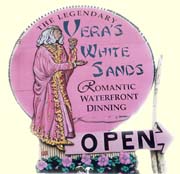

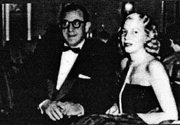
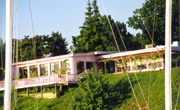
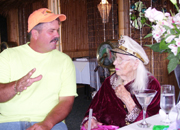
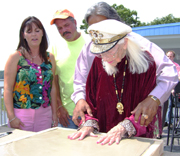

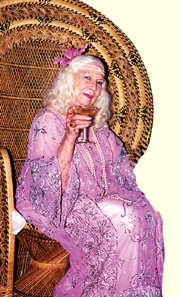 We Cannot Make Our Sun Stand Still
We Cannot Make Our Sun Stand Still